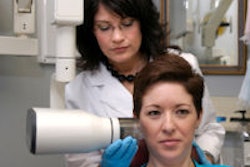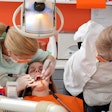
With the use of technology, the dental profession has grown by leaps and bounds. Who would have imagined that we would be using intraoral cameras, high-tech isolation systems, digital impressions, CAD/CAM technology, and laser caries detection devices on a daily basis in the dental office?
In fact, with all of these modern devices at our fingertips, it's the perfect time to be in the profession -- especially if you're a dental assistant.
There is no such thing as being "just" a dental assistant anymore. Our roles have changed for the better because of the plethora of new devices now available, changes in legislation regarding dental procedures, and the ongoing development of continuing education courses that teach dental assistants how to be a leader in the office and at chair side, improve our communication skills, and use the novel technologies now available.
I've been asked by many dentists how they can get their assistants more involved in the practice and help them become outstanding clinical assistants. I try to remind them that they need to find assistants who are not just looking for a job, but searching for a fulfilling career. The assistants must have passion and dedication. I also tell the dentists that their assistants need to take advantage of all the benefits that come with national certifications, American Dental Assisting Association (ADAA) membership, continuing education, and networking.
Developing qualities such as leadership begins with the dentists and how they promote their assistants, as well as get them involved in the practice, the team, and their own career. In assisting, just as in life, we all thrive, grow, and excel when we get the support and encouragement we deserve.
A leadership role
Most of us are not born leaders; it's something we have to learn, and we should learn this skill early in our lives. Leadership is something that must be nurtured by those who see the possibilities in another person -- a master and an apprentice.
“It's the perfect time to be in the profession.”
When I first started in this profession, I not only lacked leadership skills but a mentor who would cultivate and nurture me. It wasn't until I joined the office of Mark Hyman, D.D.S., in Greensboro, NC, that I began learning the skills that I possess today. Dr. Hyman took me under his wing and noticed my skills from the start.
After working with him for more than eight years, he encouraged me to take the exam for my dental assisting certification. I told him I was too scared to do it because I was afraid of failing. He said, "Tina, what is it that I have taught you about overcoming fear in this practice?" My answer to him was, "To take action steps." Within two months, I was taking my Dental Assisting National Board (DANB) exam.
I faced my fears, and I knew I had to step up for my dentist because our office thrives on successful leadership from each team member. Even though my certification may not be required as an assistant, it provided me with a great sense of accomplishment. I believe it's the same feeling dentists have when they pass their boards and get their license. Not all states recognize certified or registered assistants, but don't worry if you live in a state that doesn't. It doesn't mean that you shouldn't be encouraged to educate and better yourself.
New technologies
One way to understand how far dental assistants have come is to study our history. I recommend reading the article "History of Dentistry, the First Dental Assistant" by Louise Tucker. She writes about Mrs. Kells, one of the first dental assistants, who lived in New Orleans and served as "Lady in Attendance" in 1885 to her husband, Dr. C. Edmund Kells. Tucker wrote that "a lady in attendance made it respectable for female patients to go into a dental office without being accompanied by their husbands."
Fast forward to today. Think about what we as assistants can do now in the new millennium. Not only are we ladies in attendance, we are leaders in dental sciences and technologies. We handle purchasing and inventory, and communicate with patients to recommend treatments. We are proficient in helping our practices become more profitable than ever before. We can use caries detectors to help educate and create a sense of urgency to the patient if any changes are found. We use intraoral cameras to help patients see and take ownership of their oral healthcare, and also use isolation devices that help us be more efficient and have quality saliva contamination control.
Other high-tech advances that have benefited our profession include CAD/CAM, which allows the dentist to go on to the next patient while the assistant is designing a partial or full crown. The dentist is now able to use his or her time more wisely by working with the team, which in turn makes the practice more profitable. Some CAD/CAM companies have taken it a step further, allowing the user to send impressions by e-mail. This means that, when serving as an assistant/purchasing agent, we are able to help keep down the cost of impression material for the practice. Sometimes assistants are even empowered to be "superheroes," helping patients who have an emergency by providing them provisional temporaries until a permanent crown is prepared.
Educational resources
As manufacturers continue to recognize the accomplishments of dental assistants, the profession continues to move forward at rapid pace. We continue to look for our dentists to tell us they believe in our abilities and our commitment to excellence.
Every dentist should ask their dental assistant the following questions:
- What are your dreams?
- What would you like to see differently in assisting?
- If I told you there were ways you could help improve the assisting profession, would you take these steps?
- Would you be willing to meet with a group of assistants committed to leadership and excellence at least once a month for an hour?
Letting someone know that you believe in them and that they can make a difference is only the beginning. Dentists should encourage their assistants to get in touch with the ADAA and inquire about local dental-assisting societies. If one isn't close by, then there may be an opportunity for the assistants to create a local society to benefit the surrounding dental communities. This could be a life-changing experience for them because they can establish a program from the ground up.
Assistants dream of climbing the career ladder; however, many assistants and dentists are not aware of the educational opportunities associated with the ADAA and DANB. Assistants can achieve their fellowship and mastership in dentistry, but to do this they have to take the first step by contacting the ADAA, where they will receive information on how to apply for the fellowship and mastership programs. Assistants must have 300 hours of continuing education to receive fellowship after enrollment. If assistants are already DANB-certified, then they are already halfway there because the certification automatically provides 150 credits toward their fellowship program. This program allows clinical/business assistants to achieve their goal within 10 years.
Cinderella articulated it well when she sang, "A dream is a wish your heart makes." When you have tapped into another's dreams and goals, you have hit a gold mine because you have asked them to share their hearts. This opportunity is open to every member of the dental team right now.
Tina Calloway, C.D.A., served in the U.S. Navy in 1992 and received her dental assisting training in Marietta, GA. She has worked in dentistry for 14 years as a full-time dental assistant, is past president of the Piedmont Dental Assistant Society, and currently is a clinical assisting consultant. She is a member of the North Carolina Dental Assistant Association and the American Dental Assistants Association.
Copyright © 2010 DrBicuspid.com



















